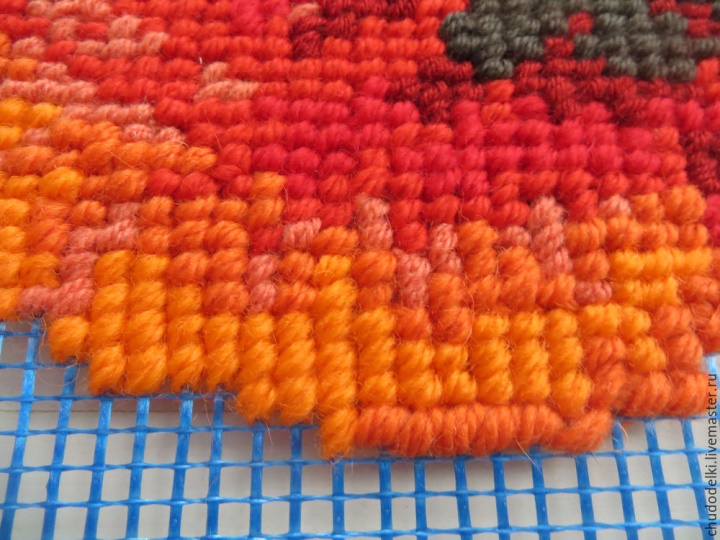Building a mesh instead of a canvas, or How to reduce the cost of materials in embroidery

Cross-stitch embroidery is a favorite pastime! I'll tell you how to save significant amounts, while not limiting yourself in the work (cross-stitching pillows, large canvases or carpet weaving ).
Fans of cross-stitch embroidery know how expensive a large canvas is, especially a embroidery or carpet technique. Okay, if you need a small piece, and if you want to embroider a big picture, or even a huge one? Horror, how much it will cost!
But there is a way out! The construction grid for cross-stitching (a large cross) is a super-find. Only the grid is not anyhow, but "reinforcing, under the plaster" (in its direct function it is attached to the wall, and plaster is applied on top of it). Sold in any construction shop. There are different colors, I met a blue one.

In the store, I "examined" the grid for 30 minutes, no less. Long and tediously measured the cells, bent the tip and looked at the "strength." Verdict: 90% of cells of the same size (5 mm, i.e., 1 cm = 2 cells); The remaining 10% slightly differ - 4-6 mm. The overlapping of cells (the mesh itself) - thin, even, and most importantly, strong - will not break at work.
And the price is a song! All this roll (1 meter wide and 10 meters long) costs about as much as one meter cut of the Stramin. Can you imagine how many beautiful things you can embroider from such dimensions?
And now a report on the use of this grid with embroidery.
Scheme for embroidery cross (poppies) found on the Internet. In the original it is embroidered on a canvas № 14, and its finished size is only 46 cm x 17 cm (256 cells per 98 cells).
I recount the scheme of embroidery on the cells of the building mesh.
The width of the cell is 0.5 cm x 256 cells = 1 meter 28 cm long.
The cell width is 0.5 cm x 98 cells = 49 cm width.
Scaled, right? That's the size I cut off from the grid (with a margin).

Immediately advice: when working, the edges of the net begin to unfold a little, so before embarking, it is better to glaze them with Titan glue (or shampoo).
I sew ordinary yarn in 2 threads. I prefer to take yarn thick, I take acrylic.
Embroidery with a cross (the most ordinary counting cross). The grid color completely overlaps, as it should be. In the future, under embroidery, it can not be seen at all.

The photo shows that the light (pinkish) thread is thinner than the rest. They did not embroider in 2, but in 3 threads. On closer examination, the difference is visible. In the general picture, on embroidery, you can not see at all

Next, below, especially on the photo to compare the cells and texture of the embroidery:
Left fabric large canvas - 4 mm cells - cross-stitch embroidery, thick yarn.
On the right is a plastic strumin - a cell is larger - 6 mm - embroidery with a cross, thick yarn.
In the middle of our grid - cell 5 mm - embroidery cross, thick yarn.

We see that the construction grid is as perfect as on expensive substrates!
The goal is achieved: the maximum result at the minimum cost of creativity!